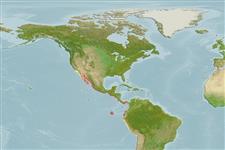>
Elopiformes (Tarpons and tenpounders) >
Elopidae (Tenpounders)
Etymology: Elops: Greek, ellops = a kind of serpent (Ref. 45335).
More on author: Regan.
Environment: milieu / climate zone / depth range / distribution range
Ekologi
marina; brackvatten; havsvandrande (Ref. 51243); djupintervall 0 - 10 m (Ref. 96339). Subtropical; 36°N - 19°S, 122°W - 70°W (Ref. 118622)
Eastern Pacific: Mandalay Beach, southern California, USA to Peru, including the Gulf of California.
Size / Vikt / Age
Maturity: Lm ? range ? - ? cm
Max length : 91.0 cm TL hane/ej könsbestämd; (Ref. 28050); common length : 50.0 cm TL hane/ej könsbestämd; (Ref. 9297)
Taggstrålar i ryggfenan (totalt): 0; Mjukstrålar i ryggfenan (totalt): 20-27; Taggstrålar i analfenan 0; Mjukstrålar i analfenan: 12 - 18; Ryggkotor: 78 - 82. Body slender and elongate; mouth large and terminal; bony plate present between branches of lower jaw; branchiostegal rays very numerous (25 to 35); fins lacking spines; lower branch of first gill arch with 16 to 20 gill rakers; scales very small, 100 to 120 in the lateral line; back dark blue-green to light brown; flanks silvery with slight yellow highlights; fins slightly yellowish (ref. 55763). Caudal rays: principal (10+8-9), procurrent (upper:8, lower: 8)
Branchiostegal rays: 23-35
Occur in schools in shallow inshore areas. Penetrate lagoons and estuaries (Ref. 9297). Feed on fish and penaeids (Ref. 50313). Spawning probably occur in the open sea and the transparent larvae migrate towards coastal areas (Ref. 9297). Struggle vigorously when caught on hooks and lines (Ref. 9297). Low commercial value due its numerous spines (Ref. 9297).
Life cycle and mating behavior
Könsmognad | Reproduktion | Lek | Ägg | Fecundity | Larver
Eschmeyer, W.N., E.S. Herald and H. Hammann, 1983. A field guide to Pacific coast fishes of North America. Boston (MA, USA): Houghton Mifflin Company. xii+336 p. (Ref. 2850)
IUCN Red List Status (Ref. 130435)
Threat to humans
Harmless
Human uses
Warning: mysqli::__construct(): (HY000/1040): Too many connections in /var/www/html/includes/func_getlabel.php on line 46
Can't connect to MySQL database (fbapp). Errorcode: Too many connections
